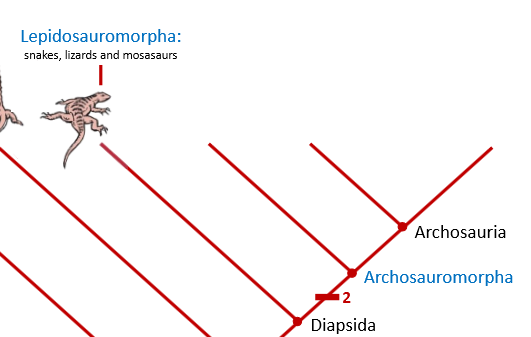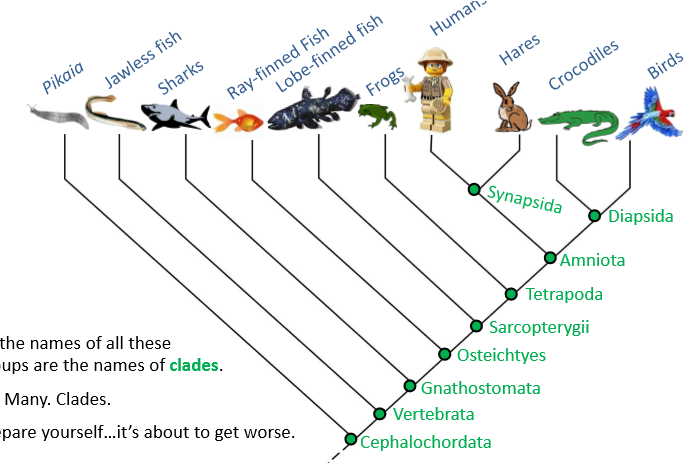7 - vertebrate evolution
1/17
There's no tags or description
Looks like no tags are added yet.
Name | Mastery | Learn | Test | Matching | Spaced |
|---|
No study sessions yet.
18 Terms
vertebral column
Belong to humans, sharks, fish, frogs, hares, crocodiles, birds
All inherited from a common ancestor
Primitive characteristic of all vertebrates
notochord
found in Ancestors of vertebrates had another cord instead of a vertebral column
Evolution of notochord is the first step towards the evolution of vertebrates
cephalochordata
Notochord + head
ex. Pikaia
Earliest ancestor of all vertebrates
Around 5 centimeters
Marine
Found in the burgess shale
505,000,000 years ago
chordates
No head, just a notochord
arculia
instead of a bony vertebral column
runs down the body
vertebra
evolved jointed vertebral column
Did not have jaws hence called jawless fish
causes them to die off cuz fish with jaw have better access to food
less likely to reach sexual reproductivity
ex. Hagfish and lampreys
gnathostomes
Evolved jaws From the pre-existing support structures found in the gills
Skeleton is made of cartilage
fossil records only contain teeth mostly and some vertebral column
Sharks
osteichthyes
Evolved calcified/mineralized skeletons
Fish
Split into two groups
Ray finned fish
Typical fish
Vertebral column, jaws, mineralized skeleton
Lobe finned fish
aka sarcopterygii
Fins become fleshy and limb like
Vertebral column, jaws, mineralized skeleton, limb like fins
ex. Tiktaalik
Until this point all vertebral life was restricted to the ocean
tiktaalik
new anatomical adaptations
Weight bearing elbows, simple wrist bones, simple fingers along with gills and lungs
Lived in shallow waters
Which is why AKA Fishapod
Fish with feet
tetrapods
Vertebrates with four true limbs
Were able to move onto land as a result
Most have lost gills but retained lungs
Primitive tetrapods are amphibians
Still need water to reproduce
Eggs are laid in water and without it they dry out
1st to move to land = ichthyostega
Bound to the water for reproduction
amniota
Membrane in eggs that allowed amny oats to be fully terrestrial
Egg is protected from being dried out
Evolution of calcified or leathery shell, yolk for nutrition, waste management system all at the same time
Some laid egg and others retain the fertilized egg internally like humans and other mammals
Two groups characterized by temporal fenestra
Synapsids and Diapsids
Can also be accommodated by bulging jaw muscles
In both, braincase is visible through the lower temporal opening
synapsids
One pair of openings behind the eyes
Only Lower temporal opening
diapsids
Two pairs of openings behind the eyes
Upper temporal and lower temporal fenstra
Includes dinosaurs so they're grouped with crocodiles and birds
Can be further split into two clades
Lepidosauropmorphs
Short non-overlapping vertebrae in the neck
Archosauromorphs
Longer overlapping vertebrae in the neck
Provide support for longer necks


clades in vertebrate evolution
Cephalochordata
Vertebrata
gnathostoma
osteichtyes
sarcoptergii
Tetrapoda
amniota
Synapsida
Diapsida

issue of reptilia (linnaean)
intended to include all cold-blooded vertebrates
but find out later that birds are dinosaurs which are warm-blooded
archosauria
Subset of archosauromorphs
Additional openings called antorbital fenestra
Between the eyes and snout
Don't know the purpose
Crocodiles, pterosaurs, birds, dinosaurs
Two groups due to the structure of the ankle
Crurotarsi
Sprawling stance
Crocodiles
Ornithodira
Upright stance
Pterosaurs, birds, dinosaurs

ornithodira
Hind limbs are positioned directly under the body
Can only move front to back
Simple hinge like ankles
Includes two groups
pterosauria
Adaptations for flight
Elongation of a digit to support a wing
Avian Dinosaurs
Dinosauria
dinosauromorpha
Before dinosauria
Digitigrade posture
Standing on the balls of the feet
Allows for longer stride
Efficient and continuous
Short bursts of speed
Most primitive were small
A meter or less
Light build
Insectivorous or carnivorous
Walked on all fours but ran bipedally
Dinosauromorphs most closely related to dinosaurs were bipedal
So primitive characteristic was bipedal
Quadrupedal evolved secondarily
Dinosaurs reverted back to the quadrupedal stance
Fossils found all over the world
Late triassic
Pangea still intact